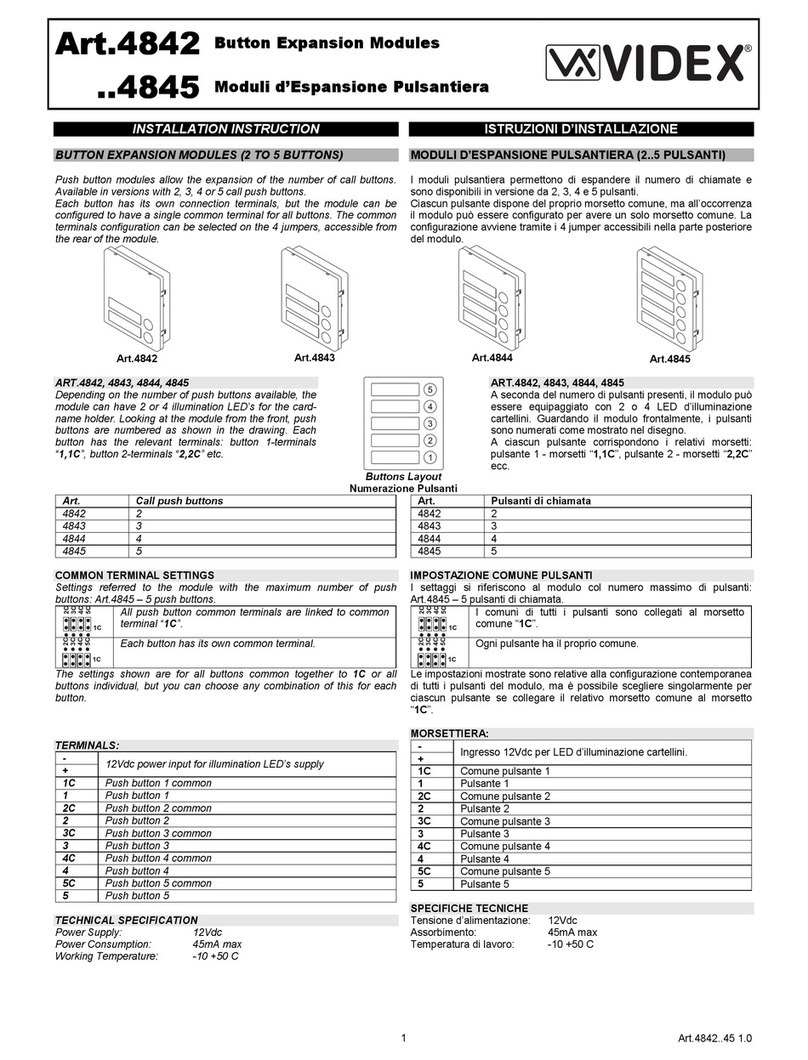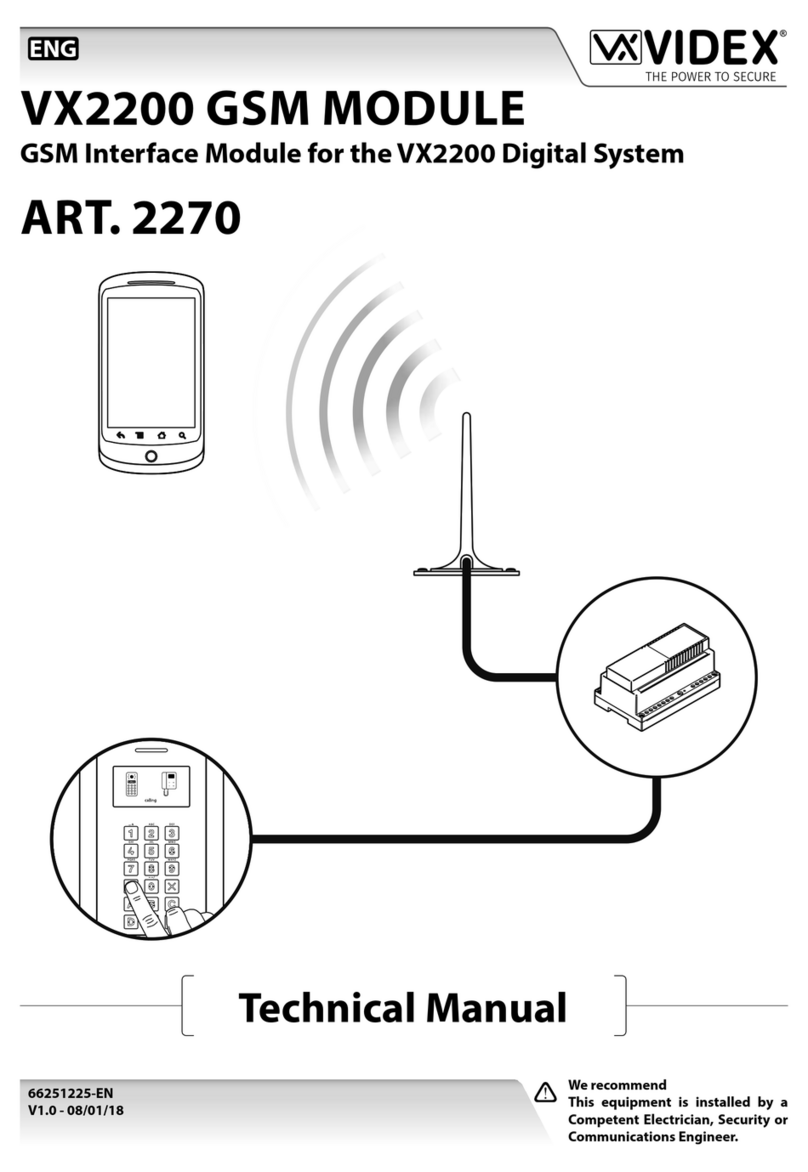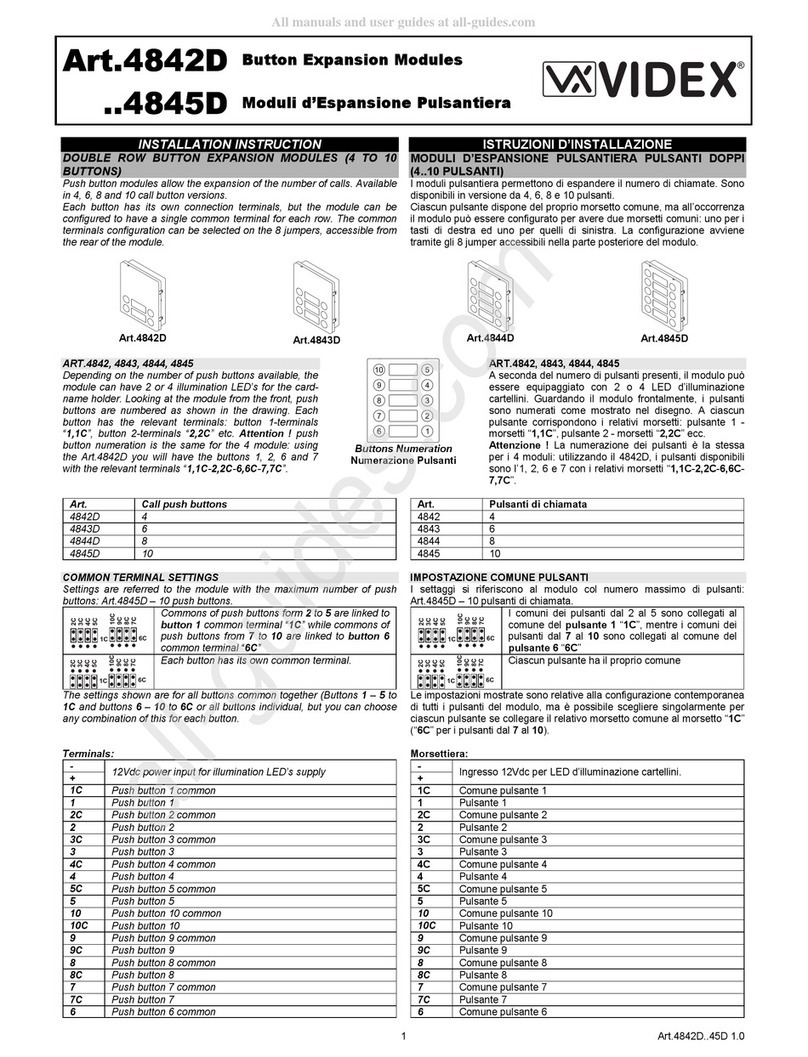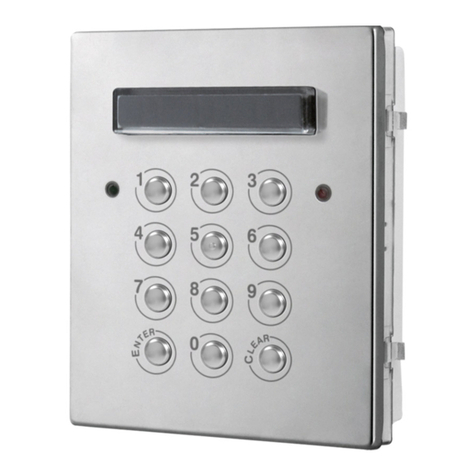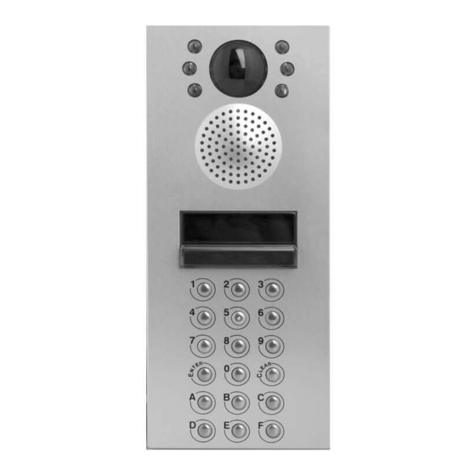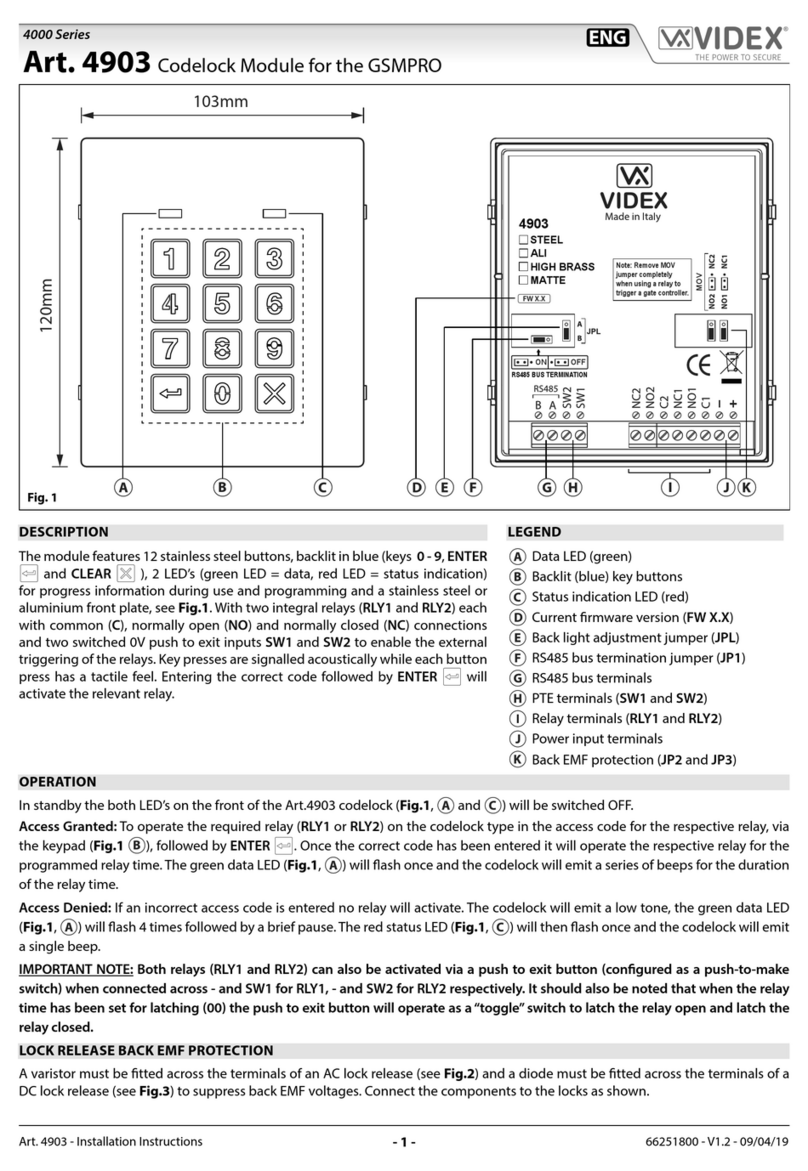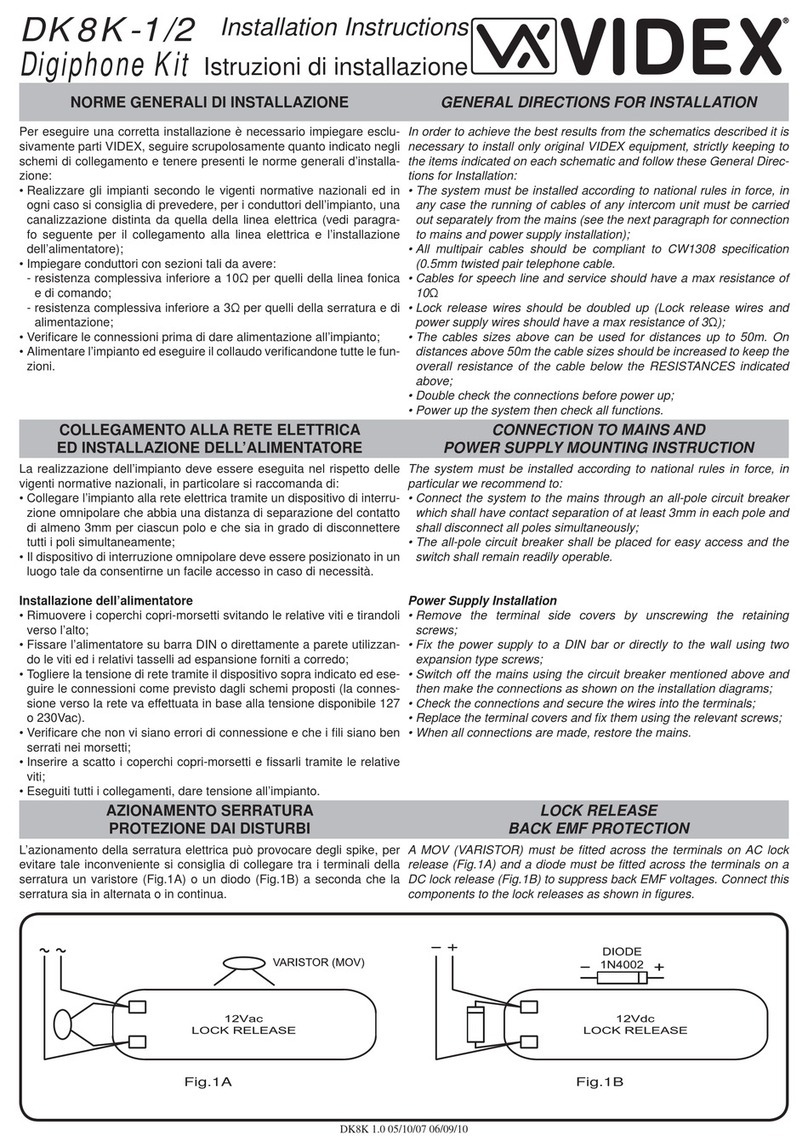
66251790 - V1.3 - 30/11/20
- 7 -
Serie 4000
Art.4902 - Istruzioni di installazione
PROGRAMMAZIONE
IMPOSTAZIONE DEL MODO DI FUNZIO
NAMENTO“NETWORK”
• Alimentare il modulo tastiera digitale te-
nendo premuto il tasto 0no a che due
lampeggi del LED rosso non confermano
l’avvenuta impostazione;
• Ripetere la stessa operazione per ritornare
al modo“standalone” che sarà confermato
da un lampeggio del LED rosso.
IMPOSTAZIONE DEL METODO DI FUN
ZIONAMENTO “STANDARD” E RIPRISTI
NO DELLE IMPOSTAZIONI DI FABBRICA
Alimentare il modulo tastiera digitale te-
nendo premuto il tasto ENTER no a che
un lampeggio del LED verde non conferma
l’avvenuta impostazione. “CODICE MASTER”,
“TEMPI RELÈ” e “ID DI UNITÀ” verranno ripri-
stinati ai valori di fabbrica. I codici memoriz-
zati restano inalterati.
IMPOSTAZIONE DEL TIPO DI CONNESSIONE
SERIALE SWITCH SUL RETRO DEL MODULO
In posizione inferiore (modo RS485) il modulo
è collegato via bus seriale RS- 485 (morsetti Ae
B) mentre in posizione superiore (modo USB)
il modulo è collegato via USB attraverso il con-
nettore MicroUSB presente nella parte poste-
riore del modulo.
TERMINAZIONE BUS 485
Se l’unità è collegata ad altre tramite bus
RS485, è necessario terminare opportuna-
mente gli estremi della linea bus:
• Per una linea BUS lunga no a 100 metri, in-
serire una resistenza da 1000Ω tra i morsetti
Ae Bdei due moduli agli estremi della linea
BUS e lasciare il jumper di terminazione in
posizione open per tutti i moduli.
• Per una linea BUS più lunga di 100 metri
no a 500 metri, inserire una resisten za da 470Ω tra i morsetti Ae Bdei due moduli agli estremi della linea BUS e lasciare il jumper
di terminazione in posizione open per tutti i moduli.
• Per una linea BUS più lunga di 500 metri no a 1000 metri, mettere in posizione close (verso l’alto) il jumper di terminazione solo
per i due moduli agli estremi del BUS.
CANCELLARE TUTTI I CODICI DI ACCESSO MEMORIZZATI
Seguire i passaggi sottostanti:
1. Rimuovere/scollegare l’alimentazione dalla tastiera
Art.4902;
2.Mettere in corto i morsetti –e SW1, vedi Fig. 5;
3. Premere e mantenere premuto il pulsante , man-
tenere premuto mentre si ripristina l’alimentazione;
4.Quando la tastiera è di nuovo alimentata attende-
re l’emissione di un bip e l’arresto del lampeggio
del LED rosso (BFig. 1) (circa 15 secondi);
5.Rilasciare il pulsante e successivamente rimuo-
vere il corto tra i morsetti –e SW1, vedi Fig. 6;
6.Tutti i codici sono cancellati.
SW2
SW1
B A
NC2
NO2
C2
NC1
C1
–
+
NO1
MOV
RS485
Made in Italy
Note: Remove MOV
jumper completely
when using a relay to
trigger a gate controller.
NO1 NC1
NO2 NC2
4902
STEEL
ALI
HIGH BRASS
MATTE
OFFON
USB
RS485 BUS TERMINATION
USB
RS485
A
BJPL
Fig. 5
SW2
SW1
B A
NC2
NO2
C2
NC1
C1
–
+
NO1
MOV
RS485
Made in Italy
Note: Remove MOV
jumper completely
when using a relay to
trigger a gate controller.
NO1 NC1
NO2 NC2
4902
STEEL
ALI
HIGH BRASS
MATTE
OFFON
USB
RS485 BUS TERMINATION
USB
RS485
A
BJPL
Fig. 6
DIGITARE IL
“MASTER CODE”
CONFERMARE O CAMBIARE IL
“MASTER CODE”
DIGITARE IL
“NUMERO UTENTE”
ALTRI CODICI ?
DIGITARE IL TEMPO RELÈ 1
PREMERE
CLEAR PER
CANCELLARE
IL COCICE
DIGITARE
IL "CODICE
UTENTE"
PREMERE“ENTER”DUE VOLTE
DIGITARE IL TEMPO RELÈ 2
DIGITARE l’ID DI UNITÀ
(necessario per l’utilizzo in
modo «NETWORK»)
IL SISTEMA È PRONTO
ALL’USO
8 volte 1 “11111111”
impostazione di fabbrica
1avolta
4 cifre (da 0001 a 2999)
NOTA: 4..8 Cifre.
La prima cifra indica il relè
da attivare:
1=relé1;
2=relé2;
0=relè1e2.
Es. il codice 148325 abilita
il relè 1
NB: se la prima cifra è
diversa da 0,1,2, il codice
attiverà sempre il relè 1
NO
SI
Digitare nuovamente 8 volte
1 o un nuovo codice
da 4 a 8 cifre
Il LED rosso si
spegne
Due cifre (01 - 64)
Tre cifre (001-255) secondi
Es. 005= 5 secondi,
00 = funz. a commutazione.
Tre cifre (001-255) secondi
Es. 005= 5 secondi,
00 = funz. a commutazione.
Premere Enter
(Il LED rosso
si accende)
Premere Enter
(segnale acustico)
Premere Enter
(segnale acustico)
Premere Enter
(segnale acustico)
Premere Enter
(segnale acustico)
Premere Enter
(segnale acustico)
Premere Enter
(segnale acustico)
(segnale acustico)
Art.4902 Modulo tastiera digitale
